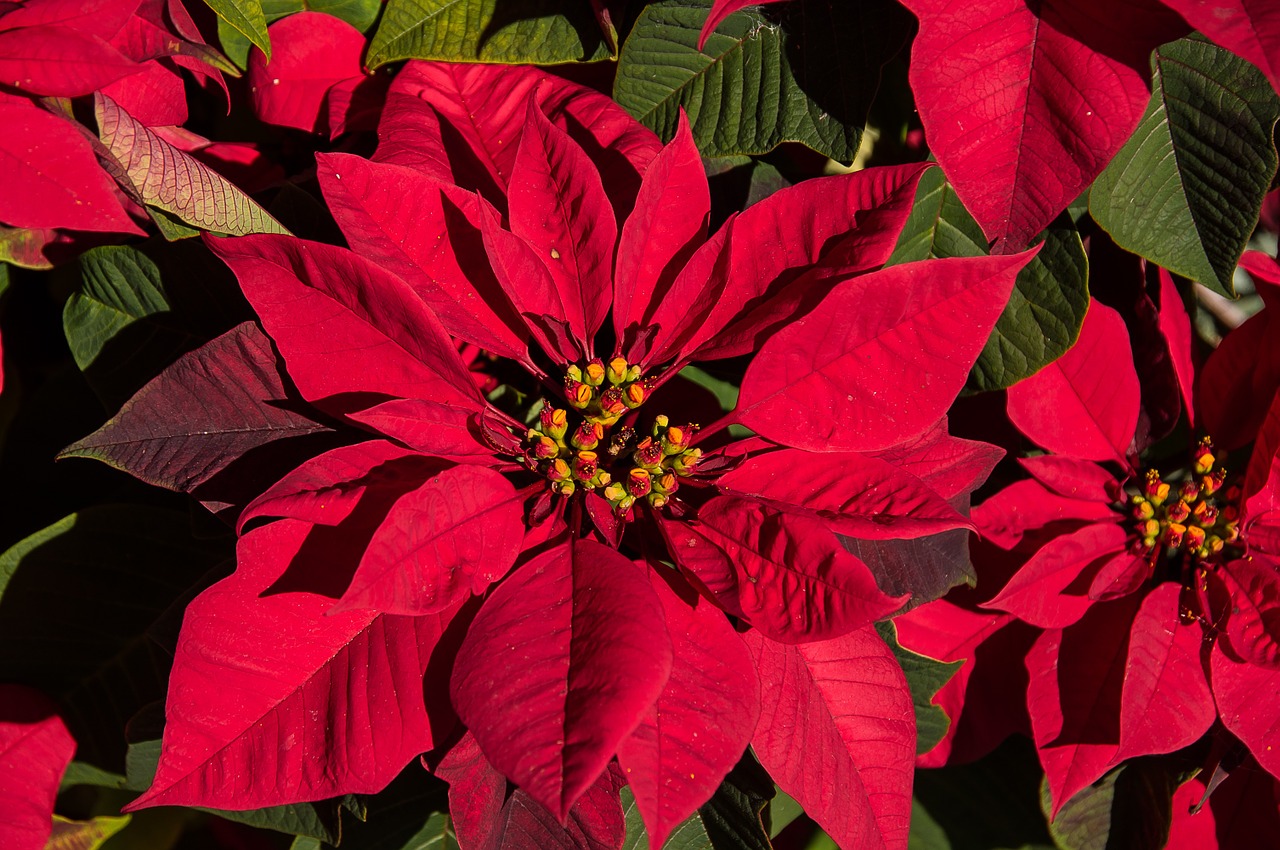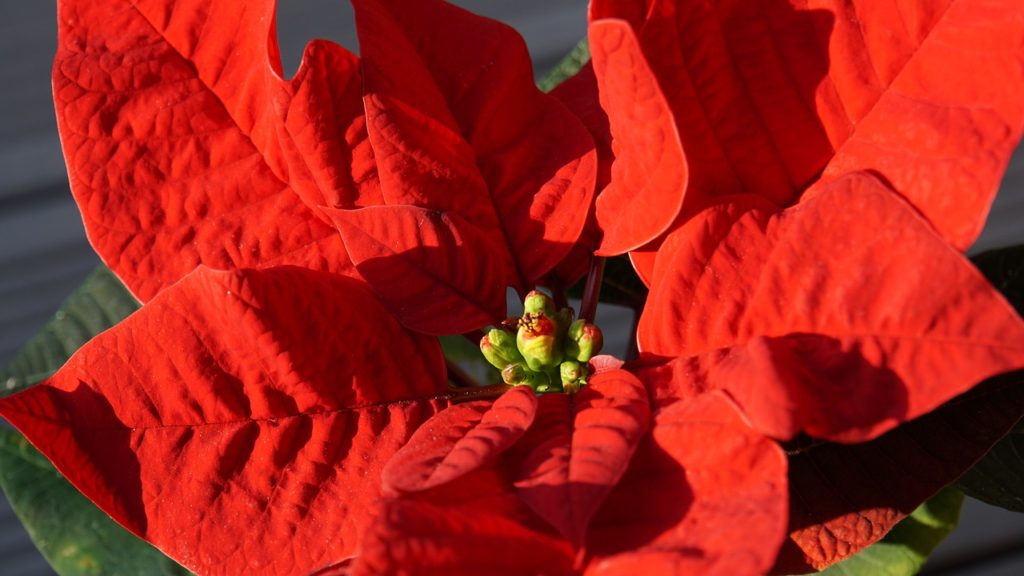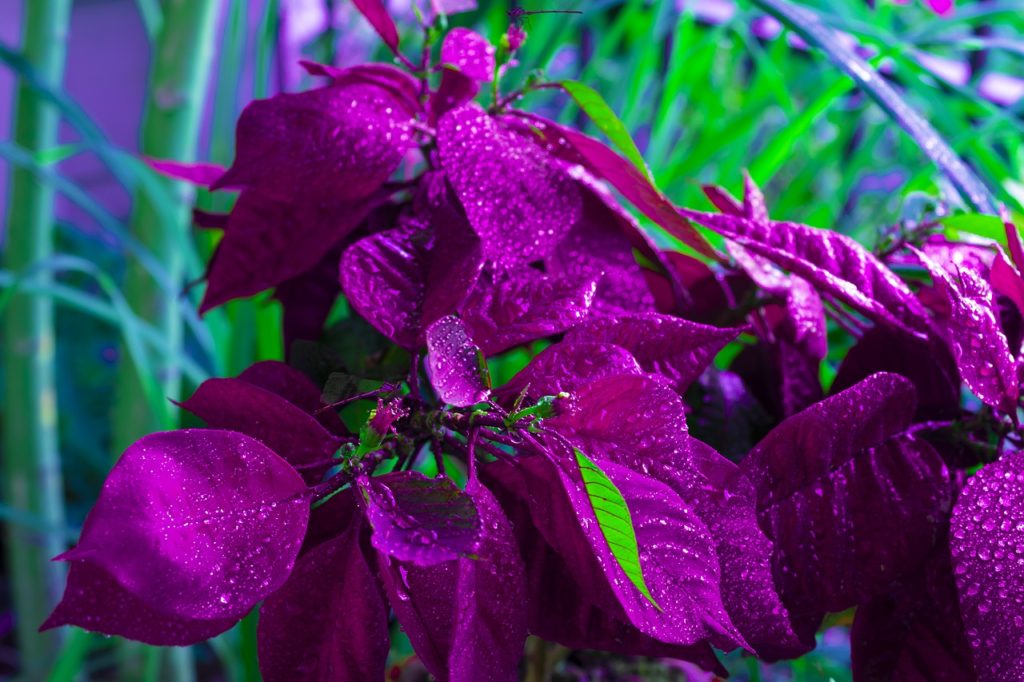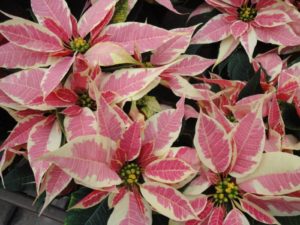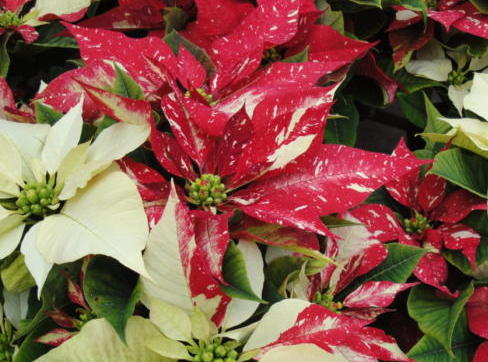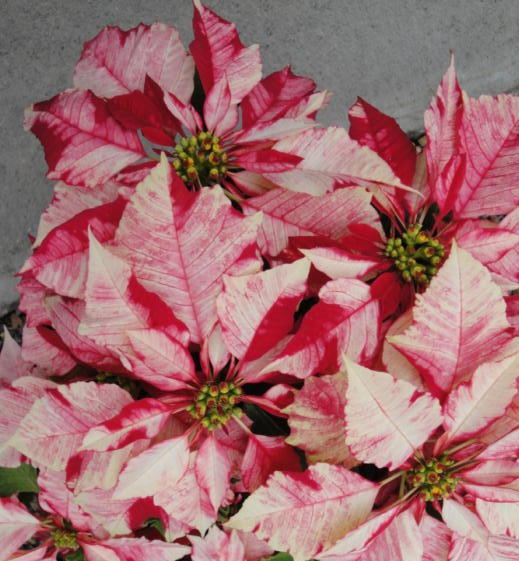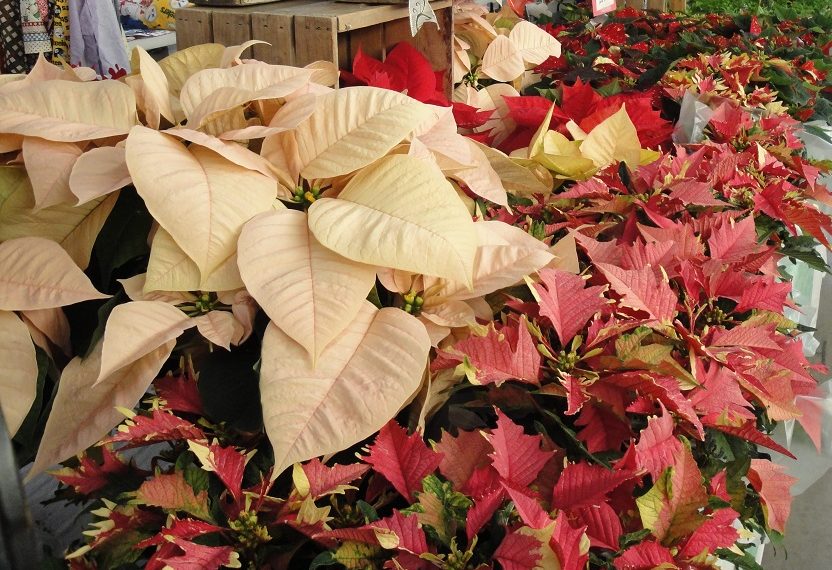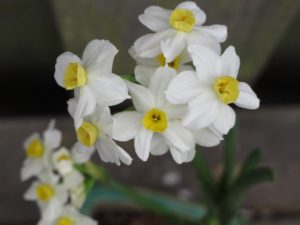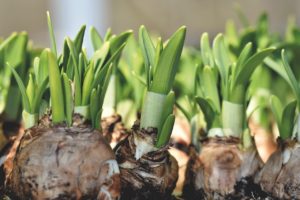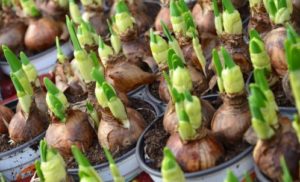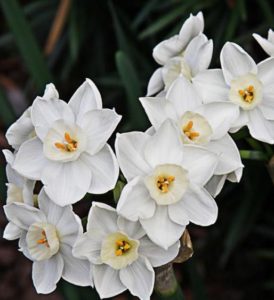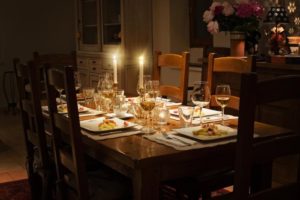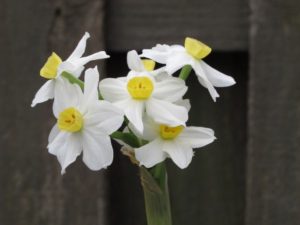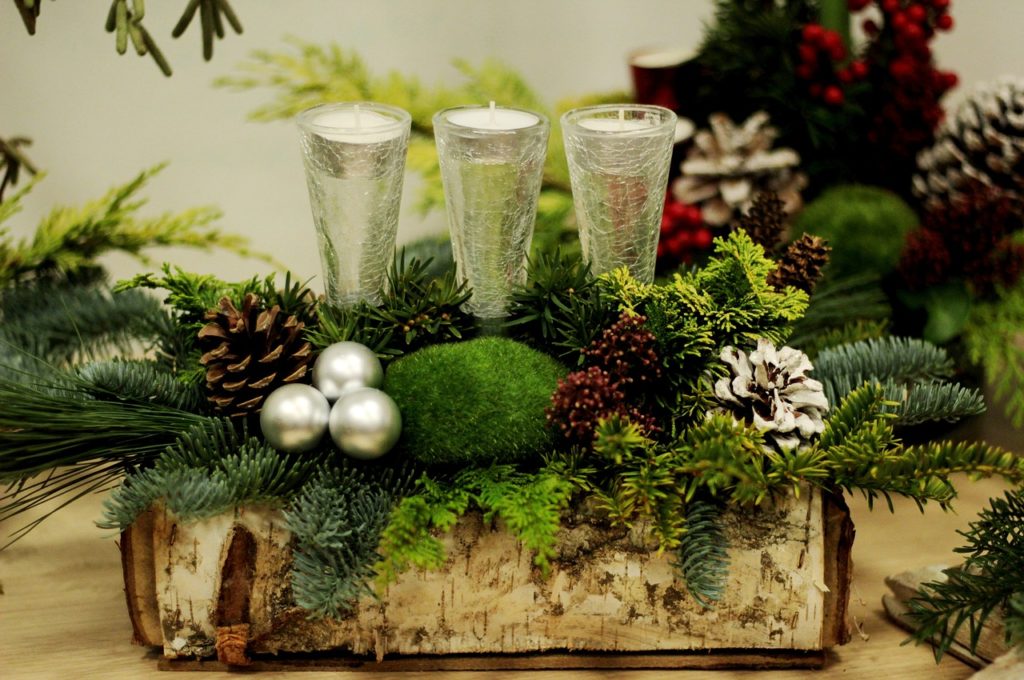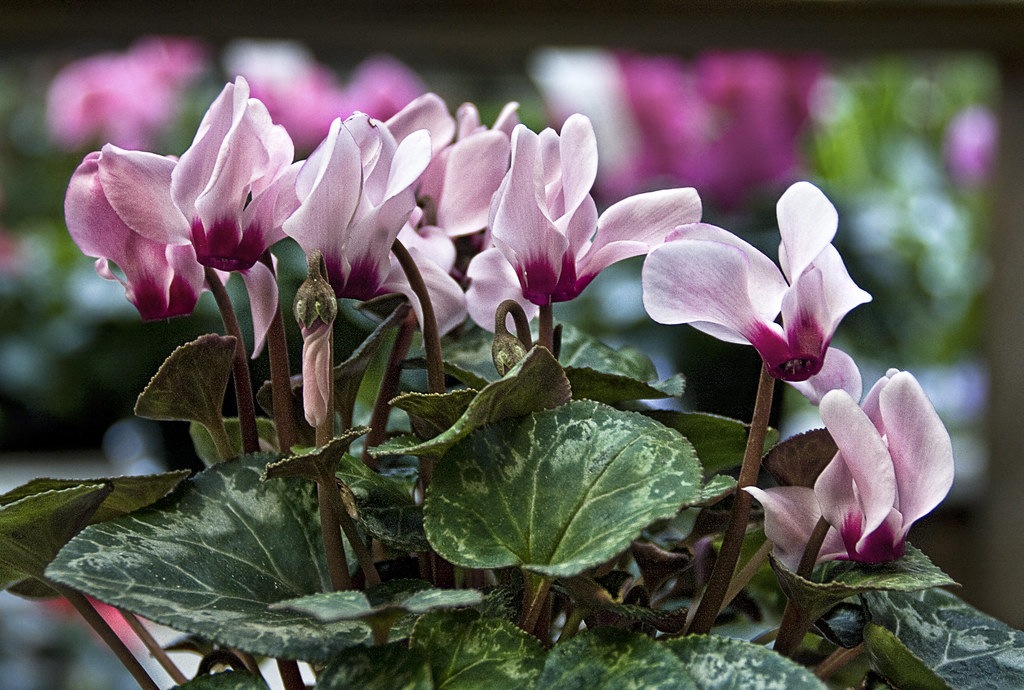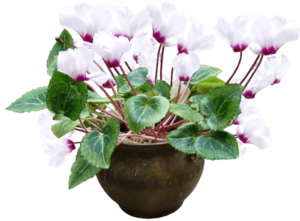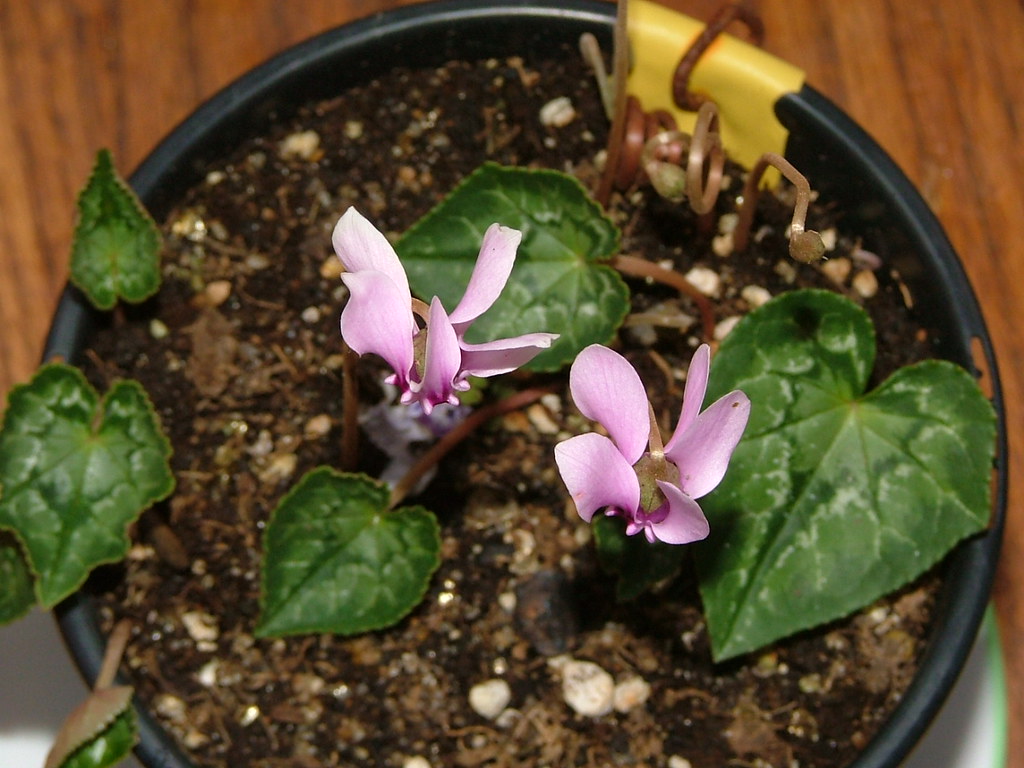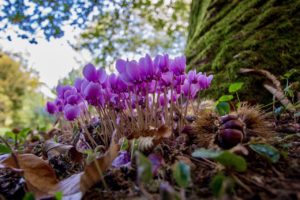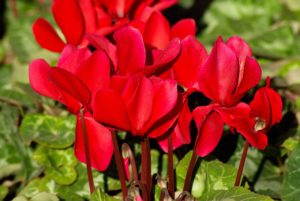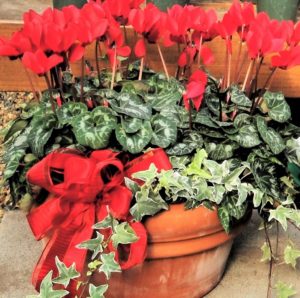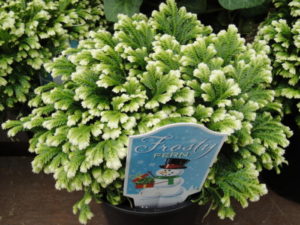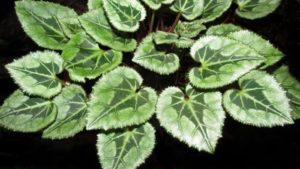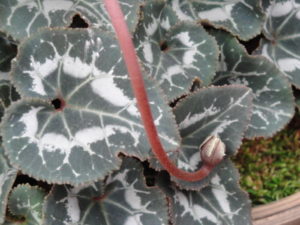Poinsettias in December
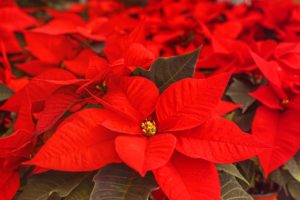
Poinsettias have long been associated with Christmas celebrations and are the most popular indoor flowering plants. They appear as early as mid-November in every garden center, grocery store, florist, Christmas craft show, and hardware store across the country.
Recently, I bought one called ‘Ruby Frost’ (bred by Syngenta). It’s a short plant that fits perfectly under a table lamp. I prefer some of the novelty colors, such as the very pale, creamy peach Premium ‘Apricot’, but I didn’t see it this year. ‘Visions of Grandeur’ (Ecke) is another favorite, with soft pale pink bracts. It is stunning when grown to a large size.
Over 100 varieties are available, with new ones advertising improved features, such as darker leaves and longer-lasting bracts. The colorful parts, sometimes called flowers, are actually modified leaves called bracts. True flowers are the small yellow and red parts in the center of the youngest bracts. Poinsettias are also being bred for resistance to necrotic leaf margins, a physiological condition where the edges of bracts or leaves turn brown due to calcium deficiency.
History of Poinsettias
As you can see from the photograph below, wild poinsettias look quite different from the ones we grow today in greenhouses. The plant is native to tropical deciduous forests of Mexico, where they grow from 2′ to 12′ tall.
Seven hundred years ago, the Aztecs called the plant Cuetlaxochitl, and used the red bracts for dye. The white latex had antipyretic properties, and the Aztecs used it for treating fever (but don’t try this at home). King Netzahualcoyotl considered the poinsettia a symbol of purity, as did the Aztec King Montezuma in the 1500’s.
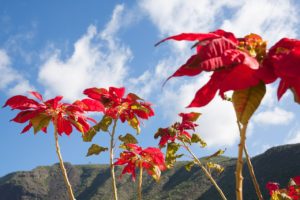
Wild poinsettia.
The first U.S. ambassador to Mexico (1825-1829), Joel Roberts Poinsett, introduced the plant to the United States in 1825 after seeing them in the area now known as Taxco. Poinsett, a physician and botanist, shipped specimens to his greenhouse in Greenville (or Charleston, depending on source), South Carolina. He also sent plants to Philadelphia botanist John Bartram, who, in turn, gave plants to Robert Bruist, a nurseryman who named them Euphorbia pulcherrima Willd.
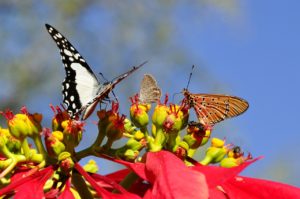
Poinsettia flowers, the cyathia.
More than 700 species belong to the Euphorbia genus, a member of the Euphorbiaceae, or spurge, family, and have in common the characteristic white sticky latex sap. A Euphorbia flower generally comprises a single female flower, without sepals, surrounded by male flowers in a cyathium (plural: cyathia). The small flowers are located in the center of the colorful bracts, which attract the attention of pollinators.
Poinsettias are not poisonous, as was previously thought. Children and family pets chewing on the leaves or stems find out fast that better things await them on, or under, the dinner table. Those rare individuals who are allergic to the sap and develop a rash should immediately seek medical attention.
The Christmas Connection
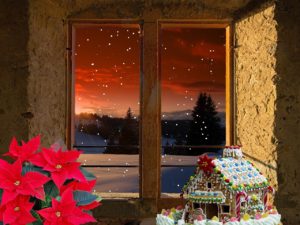
The origin of poinsettias as a Christmas tradition began in the 1500’s, in Mexico, with a poor young girl named either Pepita or Maria. Because she was unable to provide a gift to celebrate Jesus’ birthday, she was inspired by an angel to gather weeds into a bouquet and to place them by the church altar. Red blossoms sprouted from the weeds, the story goes, which turned into poinsettias.
By the 1600’s, Franciscan priests in Mexico included them in Christmas celebrations. Around the same time, the writings of a botanist named Juan Balme began to appear, describing the poinsettia.
Modern Culture of Poinsettias
In 1923, Mrs. Enteman of Jersey City, New Jersey, discovered the first oak-leaved seedling and named it, appropriately, ‘Oak Leaf’. This was the first selection suitable for pot culture. Up until the 1960’s, all selections and sports are credited with having ‘Oak Leaf’ heritage.
Poinsettias were first grown as cut flowers (‘True Red’, ‘Early Red’), and were raised in outdoor fields before moving into greenhouses in the 1960’s. Paul Ecke, a California nurseryman, began breeding, in the 1920’s, most of the varieties grown today. His company discovered a way to breed plants that branched freely. So, for decades, this secret method allowed Ecke to remain the dominant grower…until the secret was revealed by a student, this story goes. Good branching structure and shorter stems culminated in their ‘Eckespoint Freedom’, in 1992.
Pennsylvania State University, the University of Maryland, and several commercial breeding programs proliferated in the 1950’s. Dr. Robert N. Stewart, of the Univ. of Maryland’s Agricultural Research Center in Beltsville MD, bred poinsettias with stiff stems, large bracts, and new colors. ‘Paul Mikkelsen’, named in 1963, was the first long-lasting poinsettia crop. ‘Annette Hegga Red’, with multi-bracted stems from pinching, and other sports were imported from Norway in 1964.
Before these new improvements came on the gardening scene, poinsettias grew long stems and were trained to look like a paperclip—“tromboning”, it was called.
Currently, California leads the nation (total: 34 million plants) in the number of poinsettias grown. The USDA reports that, in 2013, California grew 6 million plants. North Carolina came in second, with 4.4 million pots grown. Then Texas with 3.7 million pots, and Florida and Ohio, each with about 3 million pots. Red is the most popular color, claiming ¾ of all U.S. sales, followed by white, and then pink.
Poinsettias accounted for 23% of all U.S. indoor flowering potted plant sales in 2013. They contributed $144 million of the $618 million in this category.
Varieties
- ‘Princettia’ poinsettia.
- Red poinsettia.
Looking for a basic red poinsettia is no longer a simple task. There are cherry reds and scarlet reds, deep velvety reds and burgundies. Some bloom early and some bloom later, and can last in color for months! There are plants with dark green foliage or a lighter shade of green. And there’s ‘Winter Rose’ (Ecke) with bracts that are curled, resembling a rosette. ‘Carousel’ (Ecke) adds a bit of a frill, with its wavy-edged bracts. ‘Mirage’ and ‘Lyra’ (both from Syngenta) were introduced in 2017. Every year or two, new introductions come to the marketplace.
Solid pinks, in shades from very pale to vibrant, and from clear pink to peach to salmon, broaden the palette. And, of course, there’s white, although most white poinsettias are creamy yellow and mature somewhat white, as in ‘Freedom White’ and the recent ‘Merry White’ (Selecta). The newer ‘Princettia’ series does have a pure white variety, and also several pink shades. These colors offer tones that fit better, stylistically, in many homes.
- Orange poinsettia.
- A painted poinsettia.
If bright rich orange is your color, there’s a poinsettia for you! ‘Lemon Drop’ and ‘Gold Rush’ bring even more color selections. But the traditional reds, such as the ‘Freedom’, ‘Prestige’, ‘Premier’, and ‘Viking’ series are still the favorites and readily available.
For those who dare, spray paints and glitter can be applied. White poinsettias suddenly, magically, become blue or purple! Very striking, unnatural some would say, and not for the faint of heart!
Variegated Bracts and Foliage
Variegated leaves, with creamy yellow margins, add another dimension, as in ‘Holly Point’. The newer ‘Tapestry’ (Ecke; photo, end of this section) is more vigorous than ‘Holly Point’ and more resistant to necrotic leaf margins. Foliage is gray-green in the center, and bracts are cherry red.
‘Mars Marble’ has cream margins with soft pink in the center of the bracts. ‘Christmas Angel Marbella’ (Selecta) also has creamy margins around salmon-pink centers.
For something a little different, there are series with spotted and splotched bracts. ‘Glitter’ (Ecke), ‘Shimmer Surprise’, ‘Tri-Color’, and ‘Jingle Bells’ look as if they’ve been splattered by white or pink paint. Some cultivars have yellow spots!
‘Ice Punch’ has red bracts with a blaze of pinkish white in the center. ‘Ruby Frost’ offers marbling in shades of pink, white, and red. (Note: the plant I purchased was labeled ‘Ruby Frost’, but it differs in appearance from photos in NC State Poinsettia Trials.)
- Varieties with spotted bracts have varying amounts of cream.
- ‘Ruby Frost’?
‘Strawberries and Cream’ (photo, below) is a diminutive variety, often grown in a 4 1/2″ pot. It has oak-leaved bracts that are cream on the margin and deep salmon pink in the center. Because of its size, it fits nicely in a basket with small-leaved English ivy, a Norfolk Island pine, and a young fern. Cover the pots with Spanish moss, add a bow, and you’re all set!
To hide bare stems near the bottom of the plant, simply add sprigs of evergreens and pine cones. Or use them in baskets, lined with plastic to prevent leakage, with other plants surrounding the bare stems. Keep them in the pots and move the plants around until you arrive at a pleasing arrangement.
- ‘Tapestry’, with variegated foliage.
- ‘Apricot’ and ‘Strawberries and Cream’.
Headings
Page 1: Poinsettias in December, History of Poinsettias, The Christmas Connection, Modern Culture of Poinsettias, Varieties, and Variegated Bracts and Foliage
Page 2: How To Care For Poinsettias (Growing Conditions), Outdoors For the Summer, And Back Indoors Again, and National Poinsettia Day

